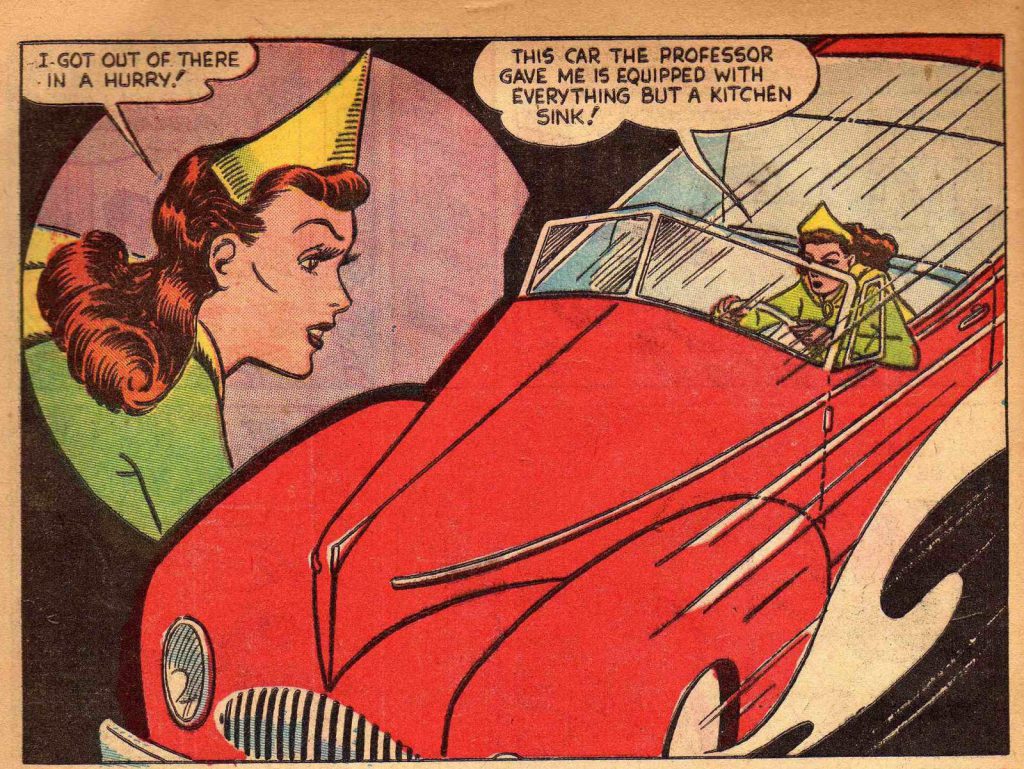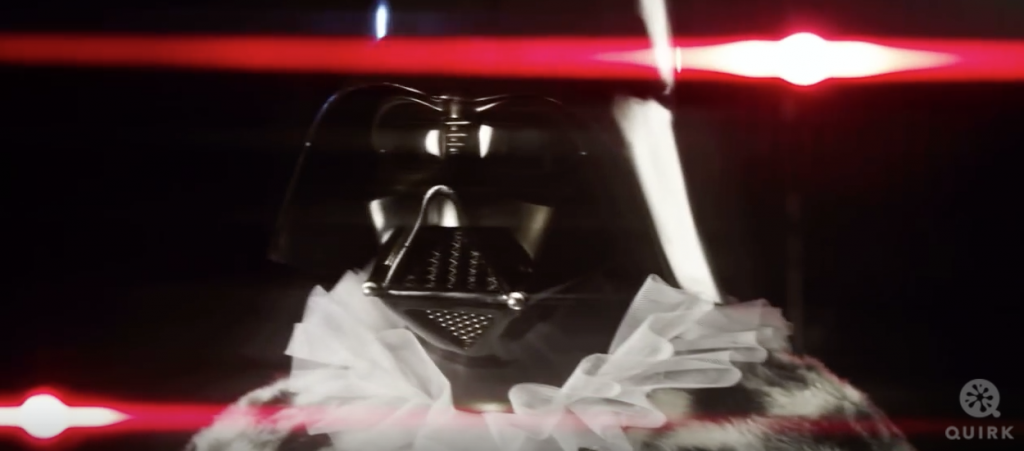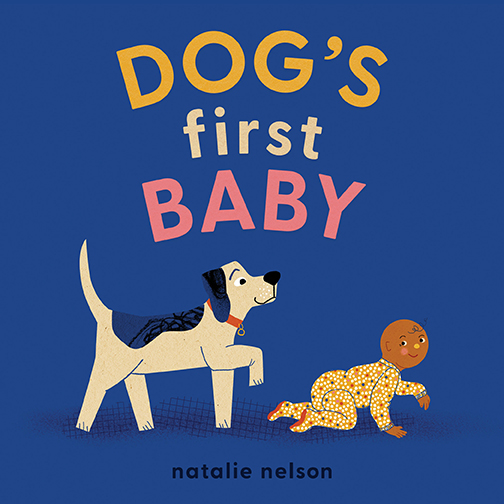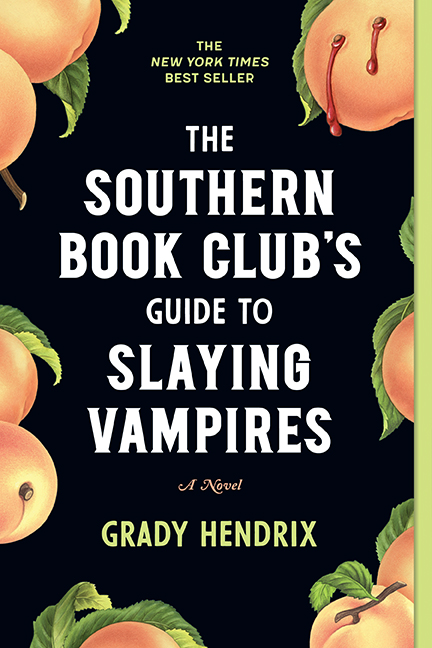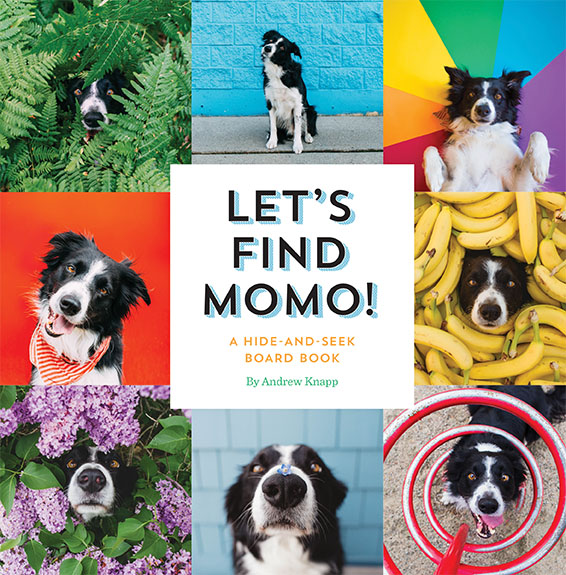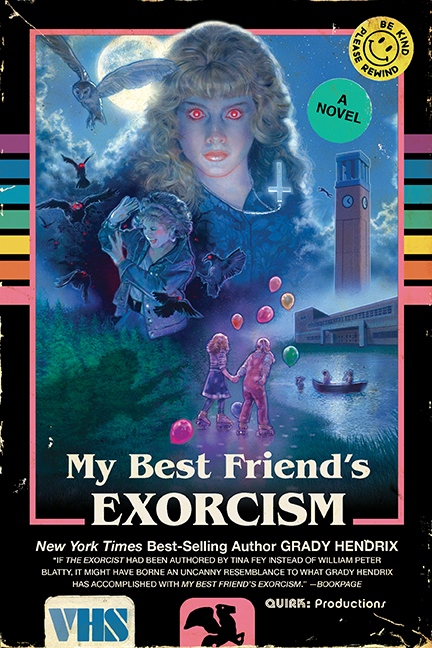Our Blog
Literary Yarns Mother’s Day Cards
Hey there, lovers of crochet and literature! With Mother's Day this coming Sunday, show Ma you care—with cards featuring adorable amigurumi. We're giving you two Literary Yarns Mother's Day cards to post to Tumblr, Pinterest, Instagram, or Facebook. Because we all know your mom is on Facebook. Just click the image to be taken to the file, and then right click and save! We hope she appreciates these literary puns as much as we do.
A for A-mazing Mom!
I've solved the mystery of the best mom ever. It's you.
Posted by Quirk Books Staff
How to Find the Greatest Mini-Comics
We told you how much we love mini-comics (a lot) and why they’re so awesome (too many reasons to fit inside these parentheses).
So are you ready to start filling your shelves with mini-comics? One of the best aspects of collecting mini-comics is that, even more so than for traditionally-published comics, no two collections are the same. That intricately-folded octagonal comic with the hand-colored front cover which you bought at an arts festival may have only been sold for six months before the creator got tired of finger-cramps. Or maybe it was one of just a hundred ever produced. If hunting for comics is sometimes like tracking big game, collecting mini-comics is like capturing rare beetles on the verge of extinction. Luckily, some mini-comics are more like ladybugs, easily acquired if you know where to look.
Whether you’re new to the world of mini-comics or already hip, here are your best bets for finding them…along with some more examples of favorite mini-comics from members of the Quirk Comics Club.
1: Go to comics shows! The first and best way to get ahold of mini-comics of all sorts and styles…and meet the people who created them. Not only does a comics expo, festival, convention, or show give you the opportunity to eyeball a slew of mini-comics in person, all at once, you’ll find creators who don’t have an Internet presence or who don’t sell their work online. That’s right, such people do exist! So a comics show is liable to expose you to minis that you wouldn’t find anywhere else. (Do your research, of course…some shows are more welcoming to independent comics creators than other.)
2: Think locally. Not all mini-comics travel very far, so it make sense to seek them out in your own backyard. Are there any cartoonists or comics creators in your area? They may sell mini-comics at local events, like art fairs or book festivals or music performances. What about your local friendly comics shop…might they have a selection of mini-comics, maybe on that shelf in the back corner where you’ve never bothered to wander? Or maybe the staff can clue you in to local mini-comic makers of note. A local library, especially in an artist-heavy town, or a college or university library, may have a few in their collection that could lead you back to the source.
3: Yes, yes, yes, OK, the Internet! We hope you’ll find opportunities to buy mini-comics directly from the creators, but there’s no denying that the Internet vastly extends your reach…and helps comics makers get their work to a much wider audience. You know how to google, but here are some leads to follow:
Start by checking the websites and social media streams of creators you know, or have heard of.
The Comics Journal offers reviews and round-ups of mini-comics, like this one. Minis referenced in older reviews may no longer be available, but their creators could have new ones on offer. You’ll also find reviews at opticalsloth.com.
Don’t overlook Etsy, which is chock full of comic-maker shops. Making mini-comics is a form of crafting, right? Start by searching for comics/handmade in the “Books, Movies & Music” category.
If you want an overview of mini-comics history, and don’t mind reproductions of the originals, Fantagraphics has you covered with a two-volume Treasury of Mini Comics set.
That should keep you busy, but remember to spend some time making space on your shelves for all the new mini-comics you’ll soon be ordering…and making. That’s right. We've also discussed how you can make mini-comics of your own (Part 1, Part 2)!
MORE OF OUR FAVORITE MINI-COMICS:
In Blintz, by Rel, three wishes and two blintzes add up to a conclusion that blintzes are awesome.
Like her full-length graphic novels, Julia Gfrörer's Palm Ash is powerful, disturbing, and grim, and beautifully drawn. The brightly colored paper she favors for her mini-comics adds a dream-like contrast to the dark doings within the pages.
Sad Animals, by Adam Meuse, ascribes the neurotic thoughts of humans to a bunch of cartoon animals. We don't know why that's entertaining, but it is.
Itching to start making your own mini-comics? Check out our How to Make a Mini-Comic: Part 1, How to Make a Mini-Comic: Part 2, and Mini Comics: The Wrap-Up for folding tips and layout tricks!
Mini-comics displayed are from the personal collections of Quirk Books Comics Club members and are intended as a small and subjective sampling of the ever-expanding universe of mini-comics.
Posted by Quirk Books Staff
Teachers in Comic Books
Superheroics are more than just jumping around rooftops and punching spandex baddies right in the mush – sometimes it requires education! Here’s a short list of just some of the superheroes who’ve made crimefighting a sideline to their teaching careers, or made their teaching career essential to their crimefighting!
Lady Fairplay
Created by:Jack Ryan
Debuted in: Bang-Up Comics vol.1 #1 (Progressive, 1941)
Teaching isn’t all glamour – in fact, it’s very little glamour at all. Perhaps that’s why mild-mannered elementary school teacher Mary Lee occasionally takes advantage of her students’ study time to slip out into the crime-filled world outside the schoolhouse walls as the “goddess of chastisement and dreaded foe of the underworld,” Lady Fairplay!
Granted amazing powers by the mysterious “Professor Amazo,” Mary finds herself possessed of tremendous strength, speed and endurance after a mysterious scientific procedure – and a swell car as well, also provided by the professor and outfitted with “everything but the kitchen sink.” Here’s hoping Lady Fairplay never runs into a crook whose sole weakness is porcelain.

1A
Created by: Russ Manning
Debuted in: Magnus, Robot Fighter 4000 A.D. #1 (Gold Key Comics, 1963)
By the 1960s, domestic automation had become the next big buzzword in American technology. Films, comics and even model homes provided examples of the “House of the Future,” a fully-automated edifice populated by specialized service robots. Effectively being robot servants, these technologies would be designed to handle everything from cooking dinner to waxing the floors to walking the dog and tucking the kids into bed at night.
For some, the promise of home automation meant the liberation from household drudgery. The new-found freedom from housework would allow homemakers to pursue their careers, education, or whatever other pastime beckoned to them in their now-generous free time.
For others, however, this automation presaged a grim future of lazy, helpless humans completely dominated by their robot servants. It was from this future-dread that Magnus, Robot Fighter, was born! A muscular machine-buster from the year 4,000 AD, Magnus made a career out of clobbering the cogs out of robot menaces and android overlords which threatened the fully-automated world of the 41st century, and all of its citizens, pampered to the point of immobility.
Magnus didn’t learn his robot-fighting all by himself, though! Nope, that was the purview of techno-traitor 1A, a highly-advanced robot whose human-like emotions also made him dread an unchallenged rule of the robots. Having been raised by 1A since infancy, Magnus learned from his foster-father-bot all the destructive arts necessary to demolish evil robots, wherever they may rear their ugly diodes.

The Super-Teacher from Krypton
Created by: Edmond Hamilton and John Sikela
Debuted in: Adventure Comics vol.1 #240 (DC Comics, 1957)
Speaking of robot teachers, few characters in the relatively tame world of the Superman mythos enjoyed quite the controversial conclusion to their careers as did The Super-Teacher from Krypton.
Prior to the destruction of Superman’s homeworld, the Man of Steel’s father Jor-El – anticipating that his son would develop super-powers once he landed safely upon Earth – designed and built a special robot teacher. Its purpose would be to train the young orphan in the use of his tremendous new abilities, but the chaos surrounding the destruction of the distant planet meant that the Robot Teacher’s arrival would be long delayed. It wouldn’t make the trip to the Last Son of Krypton’s adopted world until long after he’d begun his career as Superboy.
The Super-Teacher’s assignments for the young superhero generally tested his intellect and moral compass, more than his burgeoning powers. These are good tests for the youngster who will one day be the greatest superhero in the entire universe, but the Super-Teacher’s sense of right and wrong could have used some tweaking.
In his final appearance in 1977, Super-Teacher entered the canon’s infamy when it abducted and brainwashed a teenage girl (without Superboy’s knowledge, it’s worth mentioning). Super-Teacher then temporarily replaced her personality with one custom-generated to fit the profile of Superboy’s one true love, so as to test the Boy of Steel’s code against killing when strange creatures seemingly murdered her with a hefted stone.
Ethical lines were crossed with terrible gusto in that final tale, making the Super-Teacher’s absence from any subsequent story a genuine blessing, indeed.

The Atom
Created by:Julius Schwartz, Gardner Fox and Gil Kane
Debuted in: Showcase vol.1 No.34 (DC Comics, 1961)
No professor has quite mastered the art of the field trip like Ray Palmer. Physicist and college professor Ray Palmer, in fact, wouldn’t even have the super-powers of the mighty, miniscule Atom had he not accidentally stumbled across a piece of “white dwarf star matter” during a spelunking expedition with his students. Fashioning the celestial matter into a lens, Palmer discovers that he can change his size and the size of certain objects (for a brief amount of time – inanimate objects tend to explode if they’re left shrunk for too long), leading him to a crimefighting career as The Atom!
Although the university at which Ray Palmer taught physics was frequently only the setting for some of the Atom’s adventures, it did eventually produce his successor (albeit temporarily). Graduate student Ryan Choi proves just as brilliant as his mentor when it comes to the questionable physics of the white dwarf star matter, and takes up the identity of the Atom when Palmer retires from the superheroing game. It must be a wonderful feeling to watch a promising student carry on your life’s work.

Professor X
Created by: Stan Lee and Jack Kirby
Debuted in: The X-Men vol.1 No.1 (September 1963)
Probably no educational figure in the history of comics carries quite the cachet of gravitas as does Charles Francis Xavier, the telepathic leader of the Uncanny X-Men.
Appearing alongside the original roster of the mutant X-Men, Professor X was never just a mentor and booster; he participated in the action as well. Possessing what might be the most powerful psionic mind on the entire planet, Xavier has not only battled some of the greatest menaces of the Marvel Universe, but he’s even an adventurer in his own right. Outside of his X-Men adventures, Xavier boasting a bushel of love interests, a powerful rogues gallery (including, just to name a few, his old pal Magneto, his mega-powerful half-brother The Juggernaut, and equally powerful psionic rival The Shadow King), and a series of adventures which has taken him around the world, into the astral plane and to distant galactic empires.
But the most impressive quality possessed by Professor X is his dedication to the dream of peace and good will between the human and mutant races. Training young mutants to use their strange, new abilities at his School for Gifted Youngsters in Westchester, New York, Xavier has saved the lives and the futures of the literally hundreds of students who have passed through its doors.
Moreso, he’s ensured his legacy in the best way a teacher can – inspiring his former students to become teachers, themselves. The assorted mutant academies of the Marvel Universe have seen classes hosted by assorted X-Men such as Hank McCoy (The Beast), Ororo Munroe (Storm), Kitty Pryde (Shadowcat) and even the once-feral, stab-happy Wolverine!
Posted by Jon Morris
What’s a Mini-Comic?
Here at Quirk Books we love comics. No duh. We even have a monthly Quirk Comics Club, when Quirk staffers meet over lunch for a show-and-tell of comics we’re buying, reading, and making. Check out our neat club pin:

We love comics of all sorts, from superhero books to indie memoirs to vintage newspaper strips to the weird artsy stuff to anything with cats in it. But there’s a special place in our heart for one particular comic book iteration: the mini-comic (a.k.a. mini comic or minicomic, but let’s go with mini-comic).
What is a mini-comic?
Don’t let the name fool you; a mini-comic doesn’t have to be small, as master of comics Jessica Abel points out. But very often they're mini in stature for practical reasons, because mini-comics are a favorite method for independent comics makers to self-produce, promote, and sell their work. Creators typically make mini-comics in small batches, usually reproducing them by means of photocopier or desktop publishing hardware. When you spot a mini-comic in the wild, it’s likely to be littler than a standard published comic (because paper costs add up), and it’s probably been folded, stapled and/or bound by hand (by the artist and whatever friends and family they can con into helping).
Exception: Welcome to the Pleasure Dome by Ian Sampson is not only a mega-sized mini-comic, it unfolds into a poster-sized final panel.
The Schulz Library, at the Center for Cartoon Studies in White River, Vermont, has upwards of 3,000 mini-comics in its collection. Their curators offer this definition:
A mini-comic is small, inexpensive, short-run comic, often handmade by the creator. Typically they are about half-letter in size, since that's easiest to produce, but our collection (known as the Zine Garden) includes mini-comics that are the size of a matchbook to huge 11×17 handmade books and everything in between.
“We don't have hard and fast criteria, there's a bit of ‘we know it when we see it,’ ” Schulz librarian Jarad Greene tells us. "But usually, it's folded and stapled/stitched by hand. Self-published, perfect bound books that don't have an ISBN are sometimes included as well.”
Why are mini-comics awesome?
For so many reasons!
For one thing, a mini-comic is like a unfiltered channel of creativity, direct from the cartoonist’s brain. There are precious few barriers to creating a mini-comic—if you have time, paper, drawing implements and an idea, you’re pretty much set. Comics artists and writers can use mini-comics to experiment with concepts that wouldn’t work in larger, longer, or traditionally-published formats. A mini-comic can run with a crazy idea that might be harder to sustain in full-length comic…and that goes not just for the story and art, but also size, shape, color, packaging, and production method. You can try almost anything in a minicomic.


Destination Earth, a mini-comic by Debbie Fong, includes a fold-out diary kept by the cat-astronaut protagonist.

Mini-comics can handle personal stories, like Kate McDonough's exploration of living with social anxiety, or simple concepts, like her documentation of bizarre items she encountered while working at a thrift shop.
They’re incredibly diverse. Mini-comics can be as appealingly simple or exquisitely complex as their creators decides to make them. Some minis are minimal, just line drawings on a folded sheet or paper. Others are like little jewels, with intricate art, creative packaging, unusual shapes and sizes, fancy bindings, and/or sophisticated printing techniques.
Mark Burrier's Show Off creates dark humor with simple line-drawings.
Rachel Bard's tiny mini-comic Come Back Soon , about as tall as a jumbo paper clip, comes with a teensier comic inside it. Her Growing Hope is printed in metallic gold ink on dark blue cardstock, and comes in a wrap-around band with a cutout in front.
They suggest a personal touch. Though they’re a reproduced medium, like all comics, many mini-comics havea hand-made quality that reminds you there’s a real person on the other end…someone who took the time to plan and print and cut and fold and staple and pack them. You can buy mini-comics at comic shows and chat with a creator who might go on to become famous (comic book famous, that is…but sometimes that's still pretty famous!). If you order a mini-comic online, you might get a hand-written thank you note with your purchase. Blockbuster comics and million-seller graphic novels are great, but minis remind us that comics are a vehicle for individual creativity at all levels, and can travel from creator's brain to reader's hands with fewer stops in between tham most media.
You've probably seen Tom Gauld's cartoons in The New York Times, The Guardian, and in his books published by Drawn & Quarterly. But he once published mini-comics through his own (now defunct) small press.
They’re cheap! Inexpensive, that is. There’s not much risk in spending a few bucks to sample the work of artists you’re not familiar with and bring their nutty ideas home with you. And at few bucks a pop, you can quickly build your own mini-comics library.
So we're agreed…mini-comics are awesome! But where does one find these insanely amazing treasues? Good question…check out our How to Find the Greatest Mini-Comics post for more details! If you're already dying to make your own comic, check out How to Make a Mini-Comic: Part 1, How to Make a Mini-Comic: Part 2, and Mini Comics: The Wrap-Up for ideas!
Mini-comics displayed are from the personal collections of Quirk Books Comics Club members and are intended as a small and subjective sampling of the ever-expanding universe of mini-comics.
Posted by Quirk Books Staff
Letters of Condolences from the Empire’s HR Desk
[Photo by Rober González on Unsplash]
In honor of Star Wars Day, we're taking a closer look at the HR department's responses to Darth Vader force-choking officers. Seriously, he has to cut it out.
Posted by Jadzia Axelrod
Shakespeare’s Star Wars: Other Scripts That Should Get The Bard Treatment
Check out the book trailer for William Shakespeare's Star Wars here.
In a time so long ago begins our play,
In a star-crossed galaxy, far far away.
So ends the prologue to William Shakespeare’s Star Wars: Verily, A New Hope, the first of three plays re-telling the epic Star Wars story in the style of the Bard. Followed by The Empire Striketh Back and The Jedi Doth Return, these plays by Ian Doescher combine the magic of iambic pentameter with the beloved space opera of George Lucas – and are a perfect read for this May 4th! (Or how about organizing a staged reading, lightsabers at the ready?) Brave (Jedi) Knights and evil (Sith) Lords duke it out in elegant verse, while a love story combines with a comedy of mistaken family identity and tragic revelations for a story right up the Bard’s alley.
Posted by Rose Moore









